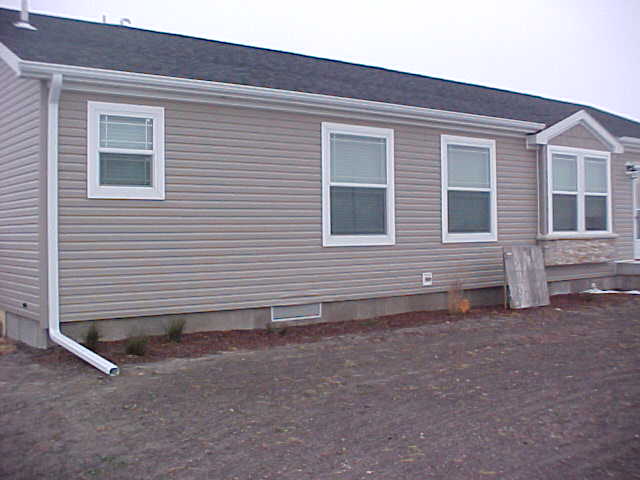By John Callen, PE, CFM
From September 2015 Floodplain Management Today
Under the ordinance provisions governing floodplain management in communities that participate in the NFIP, certain types of construction are required to have flood openings (sometimes called flood vents) in order to comply with regulatory requirements. For local floodplain managers, there are several key considerations to keep in mind when processing floodplain permit and certification requirements for buildings with openings.
Requirements and Purpose
Flood openings are used as a technique to reduce potential damage to buildings elevated on crawlspaces and are intended to allow the automatic entry and exit of floodwaters into the crawlspace. This approach provides relief from pressure exerted by floodwater on building foundations with openings, which minimizes and sometimes prevents significant damage to the structure’s foundation.
Ordinances specify several criteria for the design and permitting of structures built with flood openings. First, fully enclosed areas below the lowest floor of a building in an area other than a basement may have openings, but only if they are used solely for the parking of vehicles, building access, or storage.

This means that the fully enclosed area below lowest floor can’t be subgrade on all four sides (which is a basement). The system of flood openings must be designed to allow the automatic entry and exit of floodwaters and should either be designed for the specific structure and certified by a registered professional engineer or architect or meet or exceed the minimum criteria for non-engineered openings. For non-engineered openings, there must be a minimum of two openings having a total net area of not less than one square inch for every square foot of enclosed area, and the bottom of the opening shouldn’t be higher than one foot above grade. Covers or screens for the openings are allowed, but must be taken into account when determining the net area of the opening and whether or not floodwaters will automatically enter and exit. It is highly encouraged to have enough openings to allow floodwaters to enter and exit sufficiently around the entire perimeter of the building; for some buildings two openings may meet the minimum standards but not perform as well as desired in the event of a flood.
Certain special situations exist related to the installation of openings including appurtenant structures and below grade crawlspaces under FEMA Technical Bulletin 11. Both of these situations typically require changes to local ordinances before they can be implemented; if you believe these may apply to your community and aren’t sure if your local ordinance allows their use please contact NDNR before allowing any structures that fall into these categories to be constructed.
Certification and Compliance
In order for a building with openings to be compliant with local ordinances, the elevations of the crawlspace enclosure and next higher floor must be certified by a licensed surveyor or engineer using the elevation certificate and Diagrams 7 or 8. The square footage of the crawl space, number of openings no more than a foot above grade, and net area of the openings is provided in section A of the elevation certificate. The openings must be checked to ensure they will allow the automatic entry and exit of floodwaters and also to ensure they have enough net opening area to meet the requirements. Since determining net opening area is challenging with certain types of vents, a company has developed a guide for floodplain managers called the ‘Non-Engineered Opening Guide’ that provides the net opening area of many common opening types. It can be found by going to www.floodvent.com and clicking on ‘Resources’. There are a number of other guidance documents and resources on this website related to openings.* It is also possible to use engineered flood vents that have a certified net opening area per vent; in these cases direct measurement is not required but documentation of the number of vents and the certified opening area should be provided.
It should also be noted that in order to maintain compliance, the openings must stay in place and continue to allow the automatic entry and exit of floodwaters. It is not uncommon for property owners to either knowingly or inadvertently close off one or more openings over time. Floodplain managers can consider executing a non-engineered opening agreement with property owners in order to obtain acknowledgement that the openings should not be closed off. A sample agreement can be found in the ‘Non-Engineered Opening Guide.’
Flood Insurance
When flood insurance is rated for buildings elevated above grade crawlspaces with openings installed, it is rated on the next higher floor as shown in Diagrams 7 and 8 of the elevation certificate. If the openings aren’t installed properly, then the insurance rating level moves back to the lowest floor which is the bottom of the crawlspace. This may result in significantly higher flood insurance premiums for the structure until the deficiency in the openings is corrected.
It should also be noted that a building built with openings that has a crawlspace level below BFE will not be eligible for a LOMR-F because the base flood elevation (BFE) still ‘touches’ the building envelope, even if the next higher floor is one foot above BFE. If that is the desired outcome, the property owner will need to elevate on fill for compliance purposes rather than the crawlspace.
Real World Implementation and Performance
In real world performance, most louvered or screened openings may get clogged with debris fairly quickly depending on the duration of flooding and source of the floodwater. This will likely inhibit performance of the openings. Therefore it is highly encouraged to use openings that will remain open adequately during a flood event.
Resources
 Technical Bulletin 1
Technical Bulletin 1 Technical Bulletin 7
Technical Bulletin 7- Flood Vent*: "Non-engineered opening guide" and other resources
**Note: the website www.floodvent.com and the ‘Non-Engineered Opening Guide’ were developed by a private company. While this information is deemed to be reliable it has not been reviewed vs. FEMA guidance by NDNR. NDNR does not promote any specific product or company.









